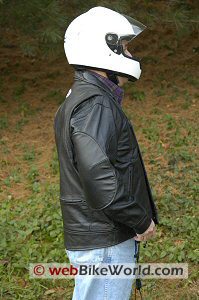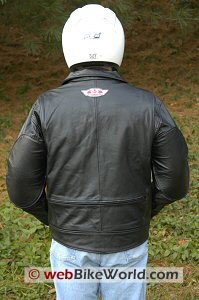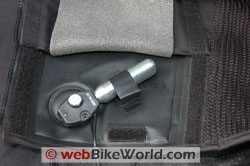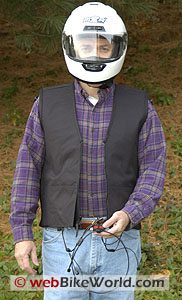Airetronics Motorcycle Air Bag Vest Review
I’m always interested in learning about new products that have the potential for improving motorcycle rider protection and safety.
I reviewed one of the first commercially available motorcycle “air bag” jackets last year, and I believe that the technology has promise.
I seem to be in the minority on this, because air-assisted rider protection seems to meet with somewhat of a derisive attitude by the press.
Online and print articles mostly dismiss the idea as a curious exercise that will go nowhere.
But it’s obvious that someone must have a vision, because several companies have continued to develop the concept.
Although air bag vests, jackets and other clothing are far from common, they’re definitely evolving, demonstrated by the Airetronics system that is the subject of this article.
It uses a slightly different approach which we think is more practical and could have the potential to be more readily accepted in the marketplace.
This technology is so new that it doesn’t actually have a consistently used name.
Some of the manufacturers have resisted using the phrase “air bag”, even though our research has shown that this seems to be the colloquial appellation for this type of product.
Should we call it an “air assisted safety device”, or maybe an “air bladder protection device” or simply an “air vest”?
Airetronics also refers to their product as a “motorcycle inflatable safety vest” that “provides a cushion of air around your torso”.
If the technology keeps evolving and becomes commonplace, surely the marketplace will develop a terminology.
Most or all of the air-assisted rider protection systems that we’re familiar with consist of a vest or undergarment that is designed to be worn under a specially equipped motorcycle jacket.
One or more CO2 canisters normally provide inflation via a mechanical trigger that engages when the rider leaves the motorcycle.
Triggering the Airbag Vest
The triggering device for the CO2 canisters is usually connected to some type of wiring harness that must be physically attached to the motorcycle.
When the rider’s body leaves the bike, a wire that’s attached to the jacket activates the triggers, piercing the CO2 canisters and instantly inflating the vest or inflatable garment.
Although the combination of the inflatable vest and the specially designed jacket may help ensure that the technology does indeed work as a system, it leaves the owner less choice regarding styling.
Also, some of the currently available vests or bladders use lots of air and inflate to a very large diameter.
This requires oversized outer garments which can seem two or more sizes too big during normal (un-inflated) use, which hopefully is 100% of the time that they’re in use.
As far as I can tell, there are no internationally accepted standards regarding this technology or its efficacy.
There are lots of questions still unanswered; questions like how fast should the product inflate? How much of the rider’s surface area should be covered?
Do they actually work; i.e., what types of injuries are reduced or eliminated? How do they compare to motorcycle armor and other types of protective gear?
Will they cause the rider to “bounce” rather than slide, and does this create a better or worse crash outcome?
Until these questions are definitively answered, the decision to purchase one can only be based on personal judgment.
Perhaps as the devices come into more common use, some of these questions will be answered.
Remember also that there are similar questions for several other motorcycle-related technologies, such as flip-up helmets, textile vs. leather apparel, types of armor, and even anti-lock brakes.
Motorcycling is indeed a sport where one makes a choice and calculates whether the personal risk level is acceptable or not.
Where to Buy Motorcycle Air Bag Vest
Check Reviews & Prices on AmazonAlso: Motorcycle Jackets, Motorcycle Gloves, Motorcycle Boots, Motorcycle Pants
Airetronics Airbag Vest and Jacket
Airetronics has taken a slightly different approach with their air-assisted rider protection system.
It uses a smaller volume of CO2, which helps make the vest a more reasonable size when inflated, avoiding the huge “life vest” look that has been associated with the technology.
The 3 lb. (1.36 kg) vest is available in several different styles, and it can be worn by itself, or fitted into one of the Airetronics jackets, or used with other brands and types of motorcycle riding apparel.
The Airetronics vest looks just about like any other type of motorcycle vest; there’s nothing too unusual about its appearance.
The outer covering of the vest is made from 500 Denier “Kodura”, which is apparently a take-off on the trademarked DuPont Cordura name, commonly used in motorcycle apparel.
The fabric is tightly woven and feels similar to canvas. Airetronics offers four different vest styles, including one made from leather.
The vests can be purchased separately, or combined with an Airetronics jacket for a modest increase in price. The jackets run the styling gamut from cruiser to sport.
Each Airetronics jacket has a provision to attach the vest, using a combination of “hook and loop” and snap-in fasteners.
We were able to fit the uninflated vest under several different jackets we tried, and found that it’s inconspicuous and relatively unnoticeable by the wearer.
Its smaller inflated volume allows it to be deployed under a wider variety of jackets than some of the competition.
Airetronics offers 6 different jacket styles, each with a provision to fit an Airetronics vest. The “Classic 1″ jacket (see below) is a modestly styled leather jacket weighing a reasonable 6 lbs. (2.72 kg). The leather is very soft, and although when new it’s a bit too shiny for our taste, it feels comfortable and broken in right out of the box.
The jacket closes with 4 metal snaps in front, and it has short zippered cuffs and expansion panels in the shoulders. The upper chest area has two zippered vent openings, each about 20 cm (8″) long.
The lower back section has a wide 40 cm (16″) zipper that also opens to allow venting.
The position of this vent may seem a bit strange, but it’s probably the only place a vent could be located because of the inflatable vest.
A single pocket is located just inside each of the two front flaps, near the lapel. These pockets close with nylon zippers, and each has a 150 mm (6″) opening and is 19 cm (~7-1/2″) deep, and can hold a generous amount of cargo.
The jacket also has two hand warmer pockets with 16 cm (~6″) openings; they’re also nice and deep at about 23 cm (9”). The elbows on the Classic 1 are covered in an extra piece of leather, providing added protection.
The vest has a zipper on the rear, up around the shoulder blades.
This zipper attaches to a matching zipper on the inside of the jacket. The vest also attaches to 3 loops, one in each arm and one at the lower back at the bottom of the vest.



Where to Buy Motorcycle Air Bag Vest
Check Reviews & Prices on AmazonAlso: Motorcycle Jackets, Motorcycle Gloves, Motorcycle Boots, Motorcycle Pants
Inflating the Airbag Vest
Two CO2 cartridges are used to inflate the Airetronics vest.
The triggers for each are located under the outer slit pockets and are permanently attached to the jacket, one on each side in the front, under the vest’s hand pockets.
The triggers are covered by a separate section of fabric, which is attached via “hook and loop” closure.
There’s also a thin piece of foam padding covering the trigger mechanism.


Arming and Deployment
To arm the vest, the trigger is looped over a metal rod, and the CO2 cartridge is screwed in place. The cartridge provides just enough resistance to prevent the trigger from engaging until the lanyard is pulled.
The harness must be attached to the motorcycle, either by looping it around a section of the frame or some other hard point.
Once it’s installed, the harness can remain in place. The harness is adjustable for length, and we had no trouble finding a suitable location on several different motorcycles.
The lanyards are attached to the harness by snapping the ends into a switch block (see photo, lower left). The tricky part is remembering to uncouple the lanyards from the switch block before getting off the motorcycle.
The Airetronics system engages with a comparatively low amount of force, estimated at about 3 lbs. It would be very easy to trigger the system when getting off the bike.
Perhaps it would be a good idea to have a sticker or some other method of reminding the rider to disconnect before leaving the bike.
But the flip side of the low-force engagement system is that it probably won’t interfere with the rider’s trajectory during a crash.
Other systems we’ve tried take very large (relatively) amounts of force to engage, leaving us to wonder if the rider might become entangled with the bike during a get-off.
Once engaged, the Airetronics vest inflates very quickly indeed. We didn’t time it, but estimate full inflation takes place within 250 to 500 milliseconds.
The tough outer skin of the vest keeps the internal air bladders very tight and close to the rider. It’s surprising at how fast the vest inflates when the lanyard is pulled. The vest deflates when the CO2 cartridges are unscrewed.
New cartridges can easily be inserted to re-arm the vest if necessary.
The vest becomes instantly tight and hugs the rider’s body, and it feels like a Mike Tyson bear hug. The air channels run vertically up and down the back, over the shoulders and down the front.
Again, it’s not clear whether or not the inflatable vest prevents crash injuries, but it certainly seems that the extra cushioning would help protect the rider.
Conclusion
Air-assisted rider protection systems will only become popular if the act of wearing them is as seamless, unobtrusive and easy as possible.
The Airetronics vest is a step in that direction. It’s virtually unnoticeable during normal use.
The only trick is remembering to attach and detach the lanyards from the harness every time the rider mounts or dismounts the bike.
Perhaps the next step will be some type of range sensor that can trigger the inflation.
This could be armed when the bike starts but intelligent enough to realize that if the bike is traveling at less than, say, 5 mph, the device will not inflate when the rider leaves the area.
In the meantime, the Airetronics vest has the potential to provide a level of cushioning when used under a matching Airetronics jacket or other riding jacket.
We recommend wearing full protective gear when riding, but we also realize that not everyone agrees, and that each rider conducts a conscious or unconscious personal risk analysis to determine what to wear for each ride.
The Airetronics products have brought air-assisted rider protection down to a more reasonable price point that is within reach of many motorcycle owners.
We think this is a good sign and we’ll continue to monitor new developments of this technology.
More webBikeWorld:
| wBW Review: Motorcycle Air Bag Vest | |
|---|---|
| Manufacturer: Motorcycle Safety Gear | List Price (2004): $299.99 (vest only) |
| Colors: Black | Made In: China |
| Review Date: 2004? | |
Where to Buy Motorcycle Air Bag Vest
Check Reviews & Prices on AmazonAlso: Motorcycle Jackets, Motorcycle Gloves, Motorcycle Boots, Motorcycle Pants
Owner Comments and Feedback
See details on submitting comments.
Other WebBikeWorld Accessory Posts





No Comment